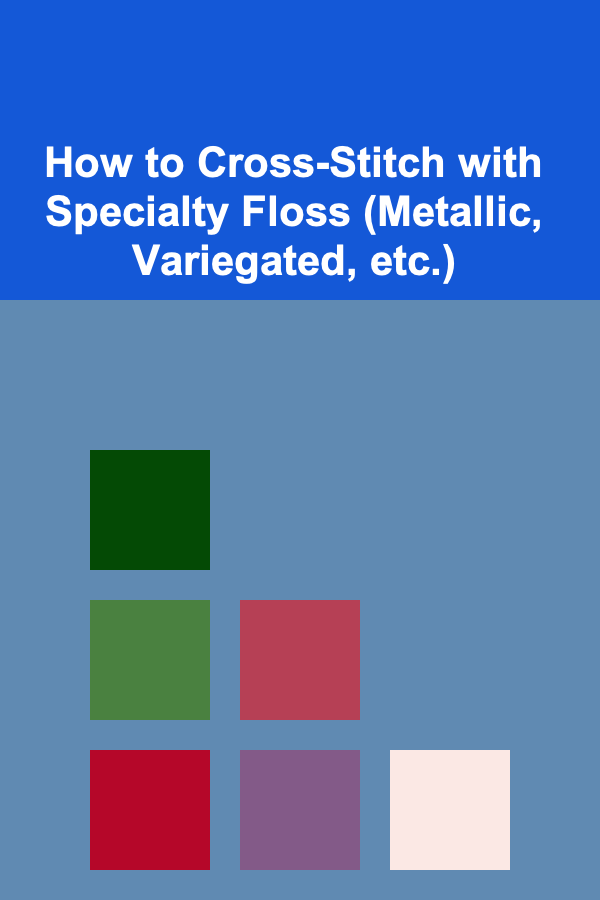
How to Cross-Stitch with Specialty Floss (Metallic, Variegated, etc.)
ebook include PDF & Audio bundle (Micro Guide)
$12.99$8.99
Limited Time Offer! Order within the next:

Cross-stitching is a timeless needlecraft that allows you to create beautiful designs with simple stitches. The satisfaction of watching a design unfold as you work your needle through fabric is unmatched, and the variety of threads available can enhance the finished piece. Among these, specialty floss such as metallic, variegated, and other unique fibers stand out, offering distinctive textures and effects that standard floss simply cannot replicate.
While working with specialty floss can add a beautiful dimension to your work, it also requires a different approach than working with traditional floss. These threads can be trickier to manage due to their texture, fragility, and tendency to fray, but with a bit of knowledge and practice, you can master the art of stitching with specialty floss. This guide will take you through everything you need to know about using metallic, variegated, and other specialty flosses in your cross-stitch projects.
Understanding Specialty Floss Types
Metallic Floss
Metallic threads add a brilliant shine to your projects. Made from fine strands of metallic materials, these threads create a reflective surface that catches the light, giving your design a vibrant, eye-catching quality. Common metallic floss includes:
- Kreinik: One of the most well-known brands, with various options in thickness and finish.
- DMC Light Effects: Offers a range of metallic threads in different colors.
- Cosmo: Known for its smooth, shiny metallic threads.
While these threads create stunning results, they can be difficult to work with. They tend to be stiffer, which can cause friction and potential breakage.
Variegated Floss
Variegated floss is a thread that changes colors as you stitch, either gradually or in distinct segments. These threads are perfect for creating gradient effects, highlighting textures, or adding a bit of surprise to your design. Variegated floss can add a level of sophistication to even the simplest patterns.
Popular variegated threads include:
- DMC Color Variations: This line is well-loved for its smooth transitions and vibrant hues.
- Weeks Dye Works: A hand-dyed floss with a unique, rustic feel.
- Gentle Art Sampler Threads: Known for their muted, antique shades with color changes that blend well.
The key to using variegated floss is understanding how the color changes will affect the design. It's ideal for pieces that require subtle changes in shading, such as landscapes, flowers, or portraits.
Other Specialty Threads
In addition to metallic and variegated threads, there are a variety of specialty flosses available. These include:
- Silk Threads: Silk offers a smooth texture and vibrant color, perfect for creating an elegant finish.
- Glow-in-the-Dark Floss: Adds a playful touch and is ideal for novelty designs.
- Floss with Beads: Some threads come pre-loaded with tiny beads or sequins, adding sparkle and texture to your stitching.
Each type of specialty floss comes with its own characteristics, and it's important to understand how to handle them properly.
Preparing Your Materials
Before you begin stitching, ensure you're well-prepared. Working with specialty floss requires extra care to avoid tangling, fraying, or damaging the thread.
Choose the Right Needle
For metallic threads, you'll need a needle with a larger eye to prevent the floss from fraying. A blunt-tipped needle is often recommended for these threads as it prevents the floss from getting caught in the fabric. A size 24 or 26 tapestry needle works well for most cross-stitch projects.
For variegated or hand-dyed threads, a regular tapestry needle should suffice, but ensure the needle is not too sharp, as this can cause damage to delicate fibers.
Fabric Selection
Specialty flosses like metallic or silk threads work best on evenweave fabrics like Lugana or linen. These fabrics allow the thread to glide smoothly and provide a solid base for intricate stitching. If you're using variegated floss, fabric that has a slightly tighter weave can help prevent the thread from slipping through the holes and creating uneven tension.
Thread Preparation
When preparing your floss, you may need to separate strands from a skein. Metallic floss, in particular, should be handled with care to avoid tangling and breaking. Some tips include:
- Metallic Floss: Metallic threads can become tangled easily. Cut a small piece, about 18 inches long, and avoid pulling from the skein directly. Work with shorter lengths to reduce the risk of tangling and breakage.
- Variegated Floss: For variegated threads, always check the color transition before starting. It helps to cut a length of thread longer than usual so that the color shifts don't interrupt your stitching.
Thread Conditioner
To help with metallic or delicate threads, consider using a thread conditioner like Thread Heaven or Thread Magic. These products help reduce friction, prevent tangling, and keep the floss from fraying. Gently pull your thread through the conditioner before you begin stitching.
Stitching Techniques for Specialty Floss
Handling Metallic Threads
Metallic floss can be stiff and fragile, which makes it trickier to handle compared to regular cotton floss. Here are some tips to help manage metallic threads:
- Use shorter lengths: Metallic floss tends to break when pulled too tightly. Work with shorter lengths of thread (18 inches or less) to maintain tension and avoid fraying.
- Don't pull too hard: Keep the tension loose to prevent breakage. Unlike cotton floss, metallic threads should not be pulled tight in order to maintain their integrity.
- Avoid over-stitching: If you're working with multiple layers of metallic thread, be careful not to over-stitch the same area. This can create friction that causes the metallic thread to wear out.
Variegated Threads
Variegated floss can add incredible depth to your design, but it requires a little more thought when stitching:
- Plan for color transitions: Pay attention to where the color changes occur and try to avoid abrupt shifts that will be visually jarring. Consider placing variegated threads where gradual transitions will enhance the design, like in shading or flowers.
- Even tension: To maintain the smooth gradient effect of variegated floss, keep your stitches consistent and even. Avoid pulling the floss too tight, as this can distort the color changes.
- Match the fabric to the floss: For subtle variegation, lighter fabrics such as white, cream, or pale linen work well. Dark fabrics may overpower the color transitions, so opt for brighter or richer tones if you're using darker variegated floss.
Using Specialty Floss with Beads or Glow-in-the-Dark Threads
When using specialty floss that includes beads or glow-in-the-dark fibers, take extra care:
- Use a bead needle: If your floss includes beads or sequins, a fine bead needle can help you thread the beads onto the floss without damaging them. Take care to stitch through the beads gently to prevent crushing them.
- Stitch in layers: If you're combining threads like glow-in-the-dark with regular floss, consider stitching in layers. Begin with the glow-in-the-dark floss and work over it with the regular floss to keep the specialty thread from losing its effect.
Finishing Your Project
Once your cross-stitch project is complete, finishing it properly is crucial to ensure that the specialty floss retains its beauty.
Pressing and Ironing
When working with metallic threads, avoid direct heat on the floss as it can damage or flatten it. Instead:
- Iron on the reverse side: Always iron your work on the back side to prevent direct contact with the metallic thread. Use a low heat setting and place a cloth or piece of fabric between the iron and your project.
- Steam: A steam iron can be helpful in gently pressing the fabric, but again, be careful to keep the metallic floss from direct heat exposure.
Framing or Displaying
Due to the delicate nature of specialty threads, framing your finished cross-stitch can be a bit more challenging:
- Use spacers: When framing, it's best to use spacers between the glass and your fabric to avoid the metallic thread touching the glass. This will preserve the shine and prevent damage.
- Avoid direct sunlight: Exposure to sunlight can cause metallic threads to fade. Display your piece in a location where it's protected from direct light to maintain its vibrancy.
Common Challenges and Solutions
While specialty floss adds beauty and texture to your cross-stitch projects, it also presents some challenges:
- Tangles: Metallic floss can tangle easily. Work with shorter lengths of thread to minimize this issue. Additionally, always store your floss properly in a thread organizer to prevent knots.
- Fraying: Metallic threads can fray and unravel. Using thread conditioners and handling the thread gently can reduce this problem. Avoid pulling the floss too tightly during stitching.
- Breaking: If your thread breaks, try using a slightly shorter length, or switch to a different needle. Using too much force while stitching can cause the floss to snap.
Conclusion
Cross-stitching with specialty floss such as metallic, variegated, and other unique threads requires a bit more skill and patience, but the results are well worth it. These threads bring an entirely new dimension to your cross-stitch projects, adding depth, texture, and a unique visual appeal that standard floss simply cannot achieve. By understanding the characteristics of each type of specialty floss, preparing your materials properly, and following the right techniques, you can confidently incorporate these threads into your designs and create stunning, memorable works of art.
Whether you're a beginner or an experienced stitcher, working with specialty floss offers an exciting opportunity to expand your skills and create pieces that truly stand out. Happy stitching!
Reading More From Our Other Websites
- [Home Family Activity 101] How to Make Fun and Easy Paper Airplanes
- [Home Pet Care 101] How to Create a Safe Outdoor Space for Your Cat
- [Organization Tip 101] How to Reassess and Refresh Your Bedroom Decor
- [Organization Tip 101] Why Organizing Your Closet Can Simplify Your Morning Routine
- [Home Family Activity 101] How to Plan a Family Science Experiment Day
- [Biking 101] The Ultimate Guide to Bike Storage: Keep Your Bike Safe and Organized
- [Gardening 101] Essential Tips for Designing a Whimsical Fairy Garden
- [Home Security 101] How to Use ADT Motion Sensors in Combination with Cameras for Better Security
- [Personal Care Tips 101] How to Make a Natural Facial Cleanser at Home
- [Mindful Eating Tip 101] The Art of Slow Eating: Reducing Food Waste Through Mindful Consumption

How to Create an Exit Strategy for Your Investment
Read More
How to Make the Most of Under-Bed Storage in Small Bedrooms
Read More
How to Secure Insurance for Your Rental Property
Read More
How to Use Labels for Easy Identification of Plants
Read More
How to Understand Inflation and Its Impact
Read More
How to Track Fixed Expenses for Small Business Owners
Read MoreOther Products

How to Create an Exit Strategy for Your Investment
Read More
How to Make the Most of Under-Bed Storage in Small Bedrooms
Read More
How to Secure Insurance for Your Rental Property
Read More
How to Use Labels for Easy Identification of Plants
Read More
How to Understand Inflation and Its Impact
Read More